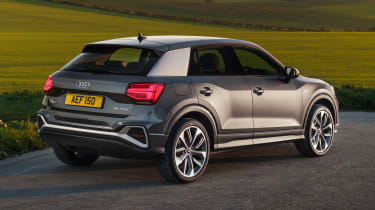Audi Q2 SUV - MPG, running costs & CO2
No diesel or hybrid engines, but the Audi Q2’s petrol engines use cutting-edge fuel-saving technology
The Q3 and A1 (which sit above and below the Q2 in Audi’s range) use the same engines as this car, as does the Audi A3 on which it’s based. These cars are known for their impressive economy, so it comes as no surprise that the Q2 is little different.
It is getting somewhat left behind, however, with a number of rivals now offered with hybrid, plug-in hybrid or even all-electric powertrains – something the Q2 misses out on. For instance, the BMW X1 is available as a plug-in or in iX1 guise with zero emissions.
Audi Q2 MPG & CO2
In the last 20 years or so, manufacturers have made great strides with diesel engines in terms of economy and emissions. Now that the tide is turning and petrol engines are becoming cleaner, greener and more economical. Audi is leading the field in this area: the Q2 is available with a three-cylinder 1.0-litre that returns almost 50mpg, with reasonable CO2 emissions, making it one of the more efficient and cheap-to-run petrol SUVs on sale today. It'll cost the standard rate per year in road tax and sits in a mid-range Benefit-in-Kind (BiK) company-car tax bracket.
The 1.5-litre '35 TFSI' petrol engine makes use of Audi’s ‘cylinder-on-demand’ system that shuts down two of the engine’s four cylinders during cruising in a bid to save fuel. This technology helps the Q2 to deliver overall economy of up to 47.9mpg, while emitting from 133g/km of CO2 dependent on trim level and specification. These are figures that, until recently, would have been the preserve of diesel-engined SUVs, with the added advantage of a smooth petrol hum, cheaper purchase and fuel prices and none of that characteristic diesel rattle.
More reviews
It’s unsurprising, therefore, that Audi dropped its diesel-engined models in 2022. In the cheapest trim, the 114bhp version could officially manage up to 60mpg, but it was more expensive to buy than the equivalent petrol and didn’t make financial sense for many buyers. Given that the petrols are so adept on the motorway and the diesels aren’t the best choice for around town, it was only a matter of time before the 30 TDI and 35 TDI engines were dropped.
Do note, as ever, that the larger alloy wheels included with higher trim levels will adversely affect the Q2’s economy figures.
Insurance groups
The facelifted 1.5-litre 35 TFSI Sport petrol sits in insurance group 20, while the 2.0-litre 35 TDI diesel engine in S Line trim finds itself in group 23. These look a little high compared with the Nissan Juke and Renault Captur, which are in groups nine to 20.
Warranty
Audi’s standard three-year/60,000-mile warranty applies to the Q2 as it does other Audi models. This is about the minimum you should expect from a new-car warranty, although you’ll be able to extend the guarantee period for an extra year or two, at a cost of between £250-£600.
Servicing
As with other Audi models, the Q2 can follow one of two different service schedules, depending on how, and how much, it’s driven. Audi recommends annual servicing for low-mileage drivers who use their cars predominantly for short trips, while high-mileage users often benefit from variable servicing schedules, meaning services every two years or so are feasible.
Which Is Best?
Cheapest
- Name30 TFSI 116 Sport 5dr
- Gearbox typeManual
- RRP£29,495
Most Economical
- Name30 TFSI 116 Sport 5dr
- Gearbox typeManual
- RRP£29,495
Fastest
- NameSQ2 Quattro Black Edition 5dr S Tronic [Tech]
- Gearbox typeSemi-auto
- RRP£46,280












